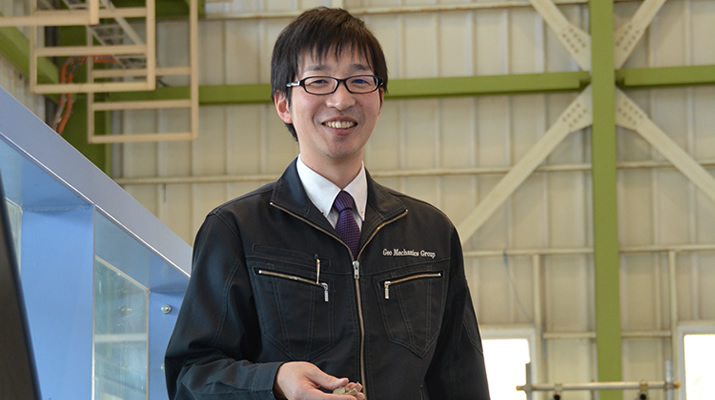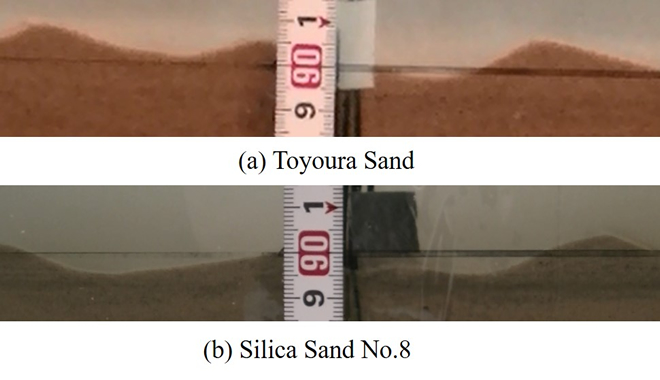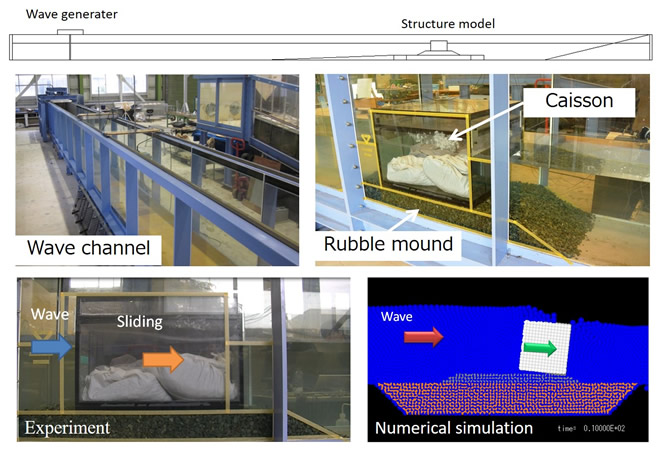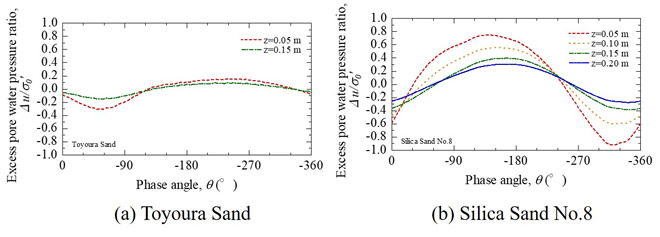
ここからコンテンツです。

Study on Earthquake Resistance and Wave Resistance of Harbors and Coastal Structures
Approaching small soil particles at the bottom of the ocean, which holds the fate of huge civil engineering structures By Tatsuya Matsuda
Matsuda, a lecturer at the GeoMechanics Laboratory, and his team are focusing on the mechanisms and the influence of earthquakes, tsunami, and high waves on the stability of the supporting ground of ports and coastal structures, and are examining the soundness evaluations of those structures. We are focusing on the complicated sediment transport phenomenon, where the driving force to the soil particles in the ground caused by the waves and the permeability generated by the water pressure fluctuations in the ground act in combination, and we are conducting observations by wave-making channel experiments. This research addresses the theme of “Thinking about the movement mechanisms of very small soil particles to evaluate the stability of huge civil structures,” with a fusion of geomechanics and water engineering research. We believe that it will prove to be very valuable, both academically and socially.
The impact of earthquakes, tsunami, and waves on the stability of the seabed is a very important research topic in evaluating the soundness of harbors and coastal structures. Until now the soundness of harbors and coastal structure foundations has usually been evaluated by means of multiple practical tests. However, there are still many uncertainties in clarifying the phenomena caused by the interactions between waves and the ground and structures, such as the damage which was inflicted on breakwaters and seawalls due to the tsunami caused by the Great East Japan Earthquake.
We are studying the soundness assessment of harbors and coastal structures, focusing on the stability of the supporting ground in respect to earthquakes, tsunamis, and high waves. In this research, we evaluate the soundness of harbors and coastal structures on multiple scales, ranging from the movement of very small soil particles to the evaluation of the stability of huge civil engineering structures, while simultaneously aiming for research fusion by collaborating with water engineering. We believe that it has a high value both academically and socially.
In order to understand how to reliably defend structures against earthquake tremors and tsunami, we have clarified the damage mechanism of the structures that accompanies the destabilization of the supporting ground, by using numerical simulations using a method called centrifuge model test or particle method, and we have studied drastic measures and design methods based on fracture control design.
Recently, we have been focusing on the complicated sediment transport phenomenon, where the driving force to the soil particles in the ground caused by the flow rate on the surface of the seabed at the wave field and the permeability generated by the water pressure fluctuations in the ground act in combination. We have been observing this process using wave-making channel experiments. The experiments are carried out on a reduced scale model of the actual conditions to be targeted. Such a scaled experiment creates the problem that the full scale phenomenon cannot be exactly reproduced in this way.
Accordingly we must consider not only the geometric scale on the length scale, but also on the mechanical/dynamical scale Normally, because influence by gravity is dominant in wave reproduction experiments, they are conducted in consideration of the similarity law according to the Froude number (the ratio of the inertial force of the fluid to the gravity). Furthermore, we are conducting our studies under experimental conditions that take into account the scale law with the actual size, focusing on the speed of soil particles falling in the water in order to examine the reproducibility of the fluctuation of the pore water pressure (water pressure in the ground due to groundwater), in addition to the movement phenomenon of the seabed ground.

Specifically, we have installed sensors to measure the water pressure in the ground and to record changes in the ground pressure where waves act. Then, to interpret the probability of the numerical values measured in the experiments, we compared the data with the numerical values obtained by the numerical solution to the scale in the real phenomenon. As a result, the experimental values of the ground pressure change that we obtained were very close to the value obtained by the mathematical solution, and we were able to determine that the stress change of the ground at the wave field could be reproduced appropriately in the experiment. It is our hope that by such methods we may come to a deeper understanding of what kind of structural damage is caused to foundations by the movements of soil, sand and waves.
巨大な土木構造物の命運を握る海の底の小さな土粒子に迫る
港湾・海岸構造物の耐震・耐波に関する研究By 松田 達也
地盤力学研究室の松田講師の研究グループでは、地震や津波、高波浪が港湾・海岸構造物の支持地盤の安定性に与える影響やそのメカニズムに着目し、それらの構造物の健全性評価に関する検討を行っています。そのための重要な実験として、波浪によって生じる地盤内の土粒子への駆動力と地盤内の水圧変動によって発生する透水力が複合的に作用する複雑な土砂移動現象に着目し、造波水路実験による観察を行っています。本研究は、「巨大ともいえる土木構造物の安定性評価のために、とても小さな土粒子の移動のメカニズムから考える」という壮大なテーマに、地盤力学と水工学との研究融合によって挑むものであり、学術的・社会的にも価値が高い研究と考えています。
地震や津波、波浪による海底地盤の安定性は、港湾・海岸構造物の健全性を評価する上で非常に重要な研究テーマです。しかしながら、港湾・海岸構造物基礎の健全性を評価する手法として、これまで、多くの検討成果が実務的に運用されていますが、例えば、東日本大震災での津波による防波堤や護岸の被災など、波浪と地盤および構造物の相互作用に起因する事象解明はまだまだ不明確な点が多いのが現状です。
我々の研究室では、地震や津波、高波浪による支持地盤の安定性に着目した港湾・海岸構造物の健全性評価に関する検討を行っています。本研究では、とても小さな土粒子の移動から巨大ともいえる土木構造物の安定性評価に至るマルチなスケールで港湾・海岸構造物の健全度を評価するとともに、水工学との連携による研究融合を図っており、学術的にも社会的にも価値が極めて高い研究と考えています。
我々はこれまで、防波堤を対象として地震動および津波に対して粘り強く構造を維持するため、遠心力載荷実験や粒子法といわれる手法を用いた数値シミュレーションを用いて支持地盤の不安定化に伴う構造物の被災メカニズムの解明を行い、破壊制御設計に基づく抜本的な対策および設計法について検討してきました。
これに加え最近では、波浪場における海底面表層の流速によって生じる土粒子への駆動力と地盤内の水圧変動によって発生する透水力が複合的に作用する複雑な土砂移動現象に着目し、それを造波水路実験により観察しています。本実験では、対象とする実際の条件に対して、縮尺した条件で実験を実施しています。このような縮尺実験においては、単純に長さを縮尺したのみでは、実現象を再現できないという課題があります。そこで、長さスケールに関する幾何学的な縮尺に加え、力学的な縮尺を考える必要があります。通常、波浪の再現実験においては重力による影響が支配的であるため、フルード数(流体の慣性力と重力の比)に従う相似則を考慮して実験を行っています。さらに本実験では、海底地盤の移動現象に加え、間隙水圧(地下水による地盤内の水圧)の変動についての再現性を検討するため、土粒子が水中を落下する際の速度に着目して実物とのスケール則を考慮した実験条件による検討を行っています。具体的には実験において、地盤内に水圧を計測するセンサを配置し、波浪が作用する地盤内の水圧変化について計測しています。そして、実験で計測した数値に対し、その確からしさを判断するため、実現象におけるスケールに対する数式解により得られた数値と比較を行いました。その結果、本実験では数式解により得られた値と非常に近い地盤水圧変化の実験値が得られ、実験において波浪場における地盤の応力変化を適切に再現できることを明らかにすることができました。
今後は、波浪による土砂の移動現象や構造物の被害メカニズムを詳細に検討し、その真相に迫りたいと考えています。
Researcher Profile

| Name | Tatsuya Matsuda |
|---|---|
| Affiliation | Department of Architecture and Civil Engineering |
| Title | Lecturer |
| Fields of Research | Geotechnical Engineering / Applied Mechanics |
ここでコンテンツ終わりです。


